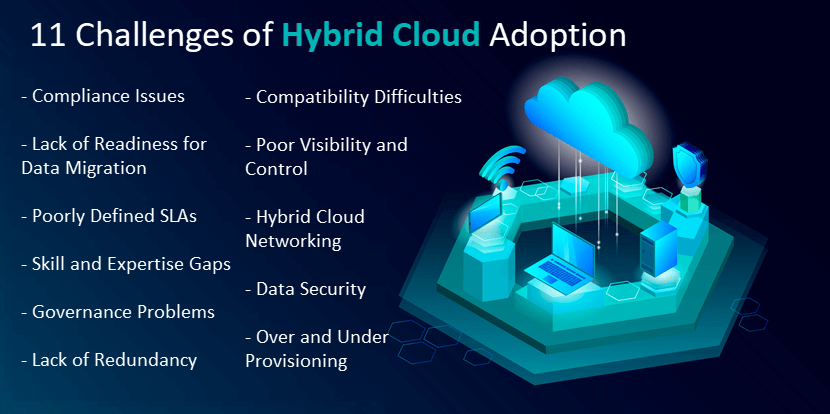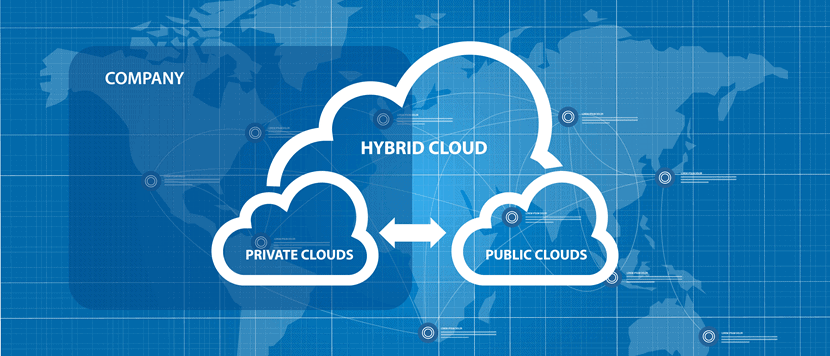Hybrid Cloud Challenges and Hybrid Cloud Adoption
A hybrid cloud is a cost-effective cloud solution that offers high flexibility, reliability, and performance. The adoption of hybrid cloud comes with some challenges, though. Most issues happen during the initial cloud setup, so solving these problems early on is a priority.
This article examines the 11 most common challenges of hybrid cloud adoption. We also explain how businesses should overcome these problems and improve their hybrid cloud environment.
Why Companies Choose Hybrid Cloud Solutions
A hybrid cloud is a combination of two or more cloud and on-premises infrastructures. A hybrid solution can include any mix of:
- Public clouds
- Private clouds
- Community clouds
- Virtual private clouds (VPCs)
- Dedicated servers
Read about different cloud deployment models and find the perfect fit for your business needs.
Every component within a hybrid cloud is a separate system with its security, access controls, and operators. While more complex than private and public solutions, hybrid cloud offers vital business benefits:
- Budget-friendly: A hybrid solution keeps costs low by using a public cloud for most workflows.
- Flexibility: The hybrid model enables companies to create custom solutions that fit their needs perfectly.
- Security: Segmented storages and workflows protect the data flowing through the hybrid system.
- Scalability: A hybrid system provides the necessary resources on short notice due to its use of the public cloud.
- More agility: A hybrid setup helps companies improve their speed to market by optimizing IT performance.
Hybrid cloud is the most popular cloud deployment model on the market. Hybrid infrastructure enables a company to store vital data on a private cloud and non-essential data on a public one. This setup maintains high performance even if the company has massive amounts of data and workloads.
Control your cloud costs! CloudAdmin tools let you monitor all your cloud costs and identify areas for optimization. Sign Up Here!
11 Challenges of Hybrid Cloud Adoption (And How to Overcome Them)

Compliance Issues
Depending on the industry and location, a company may have to adhere to a specific law or regulation concerning data usage and storage.
For example, if you operate in the healthcare sector, you must follow HIPAA compliance. If you store user financial data, your system must comply with the Payment Card Industry Data Security Standard (PCI DSS).
Use our PCI checklist to check if your business complies with the strict rules of storing financial data.
Establishing and maintaining compliance is difficult in a multi-cloud environment. Here are several tips to help you ensure compliance:
- If the company falls under a specific regulation, ensure the team includes it in the initial workload and storage planning.
- Inspect each hybrid segment both as a single entity and as a part of a unified system. Even if a component is compliant in a vacuum, the interaction between subsystems can lead to risks.
- Consider investing in staff training that explains compliance guidelines. Additional tools can also help ensure in-house processes stay within the compliance limits.
- Ensure your cloud provider complies with relevant standards and rules in your industry.
Typically, a provider proves its compliance with a government certificate.
Lack of Readiness for Data Migration
Moving to a hybrid system from another cloud or a data center is time-consuming and difficult.
Migrating to a hybrid cloud involves integrating:
- Individual cloud brands and providers.
- Native features.
- Different components (databases, machine learning (ML), cloud monitoring tools and systems, etc.).
Ensure the team performs the following tasks before starting the migration to a hybrid cloud:
- Analyze operational and performance workload features.
- Make a capacity plan and eliminate unused or underutilized services.
- Plan the provisioning of data, storage, network, security, and application stacks.
- Make current applications and workloads portable and operable across an on-premises framework.
Use our cloud migration checklist to plan a successful strategy for moving to the cloud.
Poorly Defined SLAs (Service-Level Agreements)
Read the fine print before you sign an SLA with the cloud provider. The SLA defines all the conditions, guarantees, and terms of the service regarding system uptime and data availability.
The content in the SLA must reflect your performance and security needs entirely. Both the IT and legal departments should inspect the document for potential issues.
Ensure the provider agrees to the same standards as the ones protecting your on-premises infrastructure. Failing to align the terms leads to weak points and potential dangers.
Read our service level agreement best practices to learn what a strong SLA must cover.
Skill and Expertise Gaps
Teams often rely too much on the provider to manage the hybrid cloud environment. Overreliance on outsourced help leads to inefficient decision making, potential dangers, and fewer business opportunities.
A business must train the staff on cloud computing and grow a team capable of managing a hybrid setup.
Your staff must have expertise concerning:
- Application architecture design.
- Workload processes.
- Application and integration development.
- Cloud monitoring.
Invest in team training, but also consider hiring new talent with experience in hybrid systems. New team additions offer a fresh perspective and increase the efficiency of daily operations.
Governance Problems
The goal of governance in any IT setup is to:
- Foster standardization.
- Provide oversight and direction.
- Improve IT quality.
- Speed up processes.
Companies need robust governance structures when using a hybrid cloud solution. A governance structure needs to include best practices concerning:
- Frame considerations.
- Cloud network access.
- On-demand services.
- Resource pooling.
- Elasticity.
Consider using a Cloud Management Platform (CMP) to enable single-console monitoring and management of data, security, and policies in a hybrid environment. A CMP also simplifies the cross-management of public and private clouds.
The use of CMPs is becoming increasingly popular in DevOps circles. Learn what else is on the rise by reading our predictions for DevOps trends in 2021.
Compatibility Issues
A hybrid setup uses a public and private cloud while also relying on on-premises dedicated servers. Multiple infrastructures and tech stacks in a single architecture can easily lead to incompatibility of tools and processes.
Answer the following questions before adopting a hybrid cloud:
- Can all components rely on the same set of tools?
- Does the team need to learn to use new tools to ensure compatibility?
- Are your tools and processes compatible with those of your cloud provider?
Knowing the answers to these questions before setting up the system saves both time and money.
Lack of Visibility and Control
Companies struggle to view and control all the systems in a hybrid infrastructure. Lack of visibility and control leads to:
- Difficulties implementing self-service systems.
- Low transparency of configuration settings.
- Lack of collaboration.
- Agile development problems.
Maintain a transparent and smooth-running infrastructure with automation and the right tooling:
- Automation provides the ability to share, repeat, and verify code. Use automation to simplify system management and provide better control.
- Consider adding DevOps tools to enable centralized management and visibility across the entire hybrid infrastructure.

Hybrid Cloud Networking
Correct mapping of network topology is crucial in a hybrid system due to the virtual and physical separation between components.
A network topology must factor in the security and the potential latency between internal and external resources. The network design must account for:
- Bandwidth needs.
- Management of private and public clouds.
- The locations of branch networks.
- The requirements for each application.
Most cloud providers recognize the importance of connectivity and have hybrid cloud network solutions (AWS Direct Connect and ExpressRoute, for example). However, a company should still ensure network developers understand the scalability needs of applications and how that impacts the hybrid infrastructure.
Lack of Redundancy
Lack of redundancy is the most common security challenge of hybrid cloud adoption. If there is a lack of redundancy, the backup copies are not present in the IT infrastructure.
Use backup and disaster recovery to ensure redundancy across the entire data center. You will eliminate the possibility of data loss and guarantee data availability in case of an outage.
Read about the benefits of cloud recovery and see why every business should have a backup plan for their cloud systems.
Data Security
Data is at risk both in transit and at rest in a complex hybrid-cloud environment. Methods of protecting data at rest are:
- Full-disk or partition encryption.
- Hardware encryption and security modules.
- Not making employees type passwords into encrypted drives manually.
- Making TPM a part of the NBDE to add another layer of security to hybrid-cloud operations.
The main threats to data in motion are interception and alteration. Encrypting the network session ensures the safety of data in motion. A company should use Internet Protocol Security (IPsec) to encrypt the communication between hosts that communicate using the Internet Protocol (IP).
Consider running breach-and-attack (BAS) simulations to test the resilience of the hybrid cloud.
Remember that data is most vulnerable while moving between different cloud environments, so test for DDoS protection and other man-in-the-middle attacks.
Over and Under Provisioning
Cloud provisioning is the allocation of a cloud provider’s resources and services. A hybrid cloud system uses one of two provisioning methods:
- Dynamic provisioning (or cloud bursting): This provisioning type happens when the deployment scales up or down to match the spikes and dips in usage. Billing is on a pay-per-use basis.
- Self-provisioning: A form of a managed self-service where the IT team pays for additional resources on the public cloud to match the usage level.
Consider automating the provisioning of hybrid cloud architecture by scaling distributed applications across cloud environments. Use an orchestration tool to make consumption costs transparent and avoid unnecessary overhead.
Know How to Make Full Use of Hybrid Cloud Systems
A hybrid cloud is a game-changer for businesses, but a careful approach is necessary to avoid pitfalls. Be aware of the challenges of hybrid cloud adoption and solve these issues before they end up costing you both time and money.